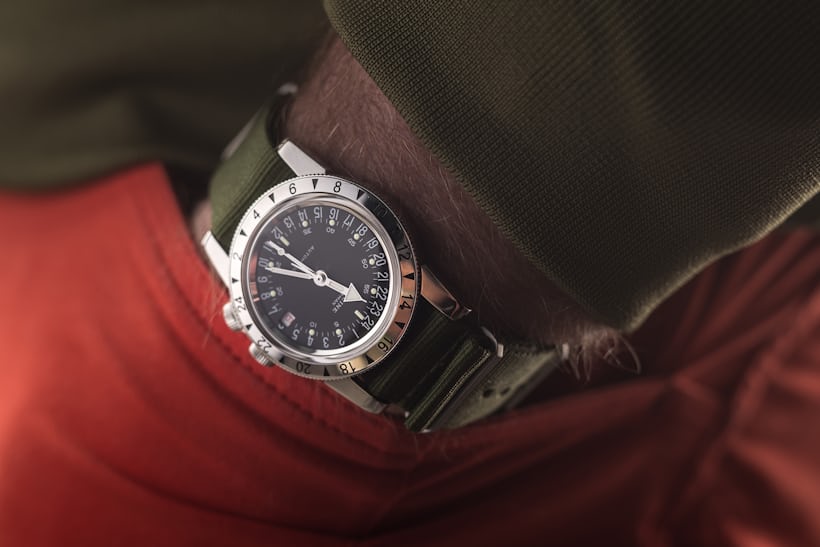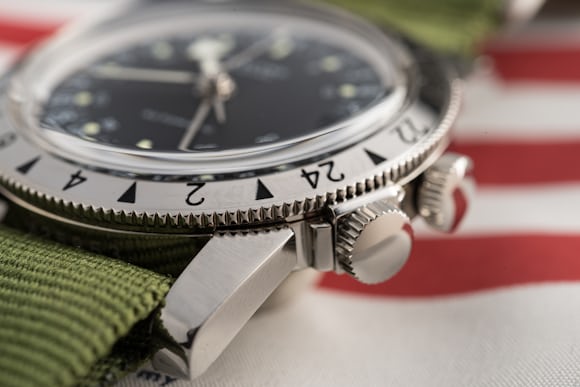“During most of my journey from Bangkok to Calcutta, I was seated at the place of the First Officer, next to the commander in a DC-4 from Thai Airways. The captain explained to me in detail what kind of watch pilots from all nations would actually need. According to him this watch is not on the market.”
Those words were penned in 1953 by Samuel Glur, a traveling executive with the Altus-Glycine watch company of Biel, Switzerland. His letter went on to list the requirements for the perfect pilot’s watch for the new era of intercontinental commercial air travel. The watch would be able to track two time zones on a 24-hour scale, giving a pilot access to both his local time as well as a GMT reference, important since GMT is the time standard referred to by air traffic control no matter where a plane is in the world.

The resulting watch, the fittingly named Glycine Airman, debuted only months later, first presented in the U.S. with a white dial and pencil hands. But it was at the 1955 Basel Watch Fair, one year after Rolex’s famous GMT-Master was released, that the black-dial Airman was presented to an international audience. While the GMT-Master, thanks in part to its legendary association with Pan Am Airlines, has gone on to great fame, skyrocketing prices, and multiple iterations, the Airman has quietly remained more of an obscure cult favorite.
Despite its niche appeal, Glycine has never really stopped producing the Airman since 1953, though some of the quartz editions of the late 1980s are regrettable. The watch has gone through dozens of versions, from the utilitarian to the downright bizarre, but in 2014, Glycine came full circle when it released the Airman No. 1, a re-issue of that very first edition of the 1950s. When one arrived for review, I had to double check that Glycine had actually sent the Airman No. 1 and not the actual Airman number 1. It is that faithful a reproduction.

The watch market these days is so rife with vintage-styled “heritage” pieces, it’s easy to get jaded by them and nitpick the details that have been sacrificed to suit modern tastes. The most obvious specification that is updated is the size. Mid-century watches were often 36 mm or smaller – undersized for the modern buyer used to bigger pieces. But the Airman No. 1 clocks in at precisely 36 mm, the exact dimension of the original watch it emulates. With the small dial and engraved metal bezel, the watch actually wears even smaller than its size, giving a true vintage feel and one I struggled to come to grips with during my week with it. Long lugs and a 20 mm strap width mitigate some of the proportions but I never quite got used to seeing such a tiny watch on my 7-1/4 inch wrist. That said, I commend Glycine for being bold enough to retain the original size. If you can’t handle a watch that small, Glycine offers other similar Airman references in larger sizes.
Another vintage feature that usually gets updated in modern “re-issues” is the crystal. Acrylic gives way to sapphire in most cases, a concession to scratch resistance over the beautiful warmth that a plastic crystal offers. Here again, Glycine stayed true to the original, with a nicely domed plexiglass crystal that has more charm than a sapphire ever will, and offering the utility of a glass that can be buffed out and won’t shatter if dropped or smacked.

Aside from the size and crystal, the Airman No. 1 continues the vintage vibe with a matte printed dial that keeps the same quaint serif font from its historical forebear. The steel case, down to its slender lugs, is high polished stainless steel, typical for a 1950s watch but less common on modern “tool” watches, and was something else to get used to (and difficult to photograph). The dial markings – small lume pips at the five-minute marks – and the hands have a creamy luminescence to them without the extreme faux patina some other throwback watches use. Rather than trying to emulate aged lume, it seems that the paint used here emulates how the Airman’s original 1950s tritium lume would have looked when new – more ecru than the sickly green of so much Superluminova.
The 24-hour bezel that was a hallmark trait of the original Airman is reproduced here and retains the locking feature that is pure charming 1950s technology. Rather than a ratcheting function commonly found in uni-or bi-directional bezels these days, the Airman No. 1 has a simple friction bezel that can be locked in place with a small thumbscrew crown at the 4 o'clock position on the case. It works well and is satisfying to use, though the crown no longer has the cross-hatched pattern of the original, a rare departure from history.
Glycine makes two versions of the Airman No. 1. The so-called “Purist” version, as its name suggests, is a pure 24-hour watch, with an hour hand that sweeps the dial only once per day. Thus, at high noon, the hour hand is confusingly pointing to the bottom of the dial, where 12:00 is found, while midnight, or 24:00, is at the top. This feature, with the rotating second 24-hour time scale, made the watch popular with pilots, since they were used to telling time this way, and the Airman became a popular choice of Air Force pilots during the Vietnam War. But a 24-hour watch never quite caught on with civilians used to telling time on a 12-hour dial. In that regard, the GMT-Master offers a more elegant solution, marrying a 12-hour dial with a 24-hour hand and bezel for a second time zone.

For people who prefer 12-hour time-telling, Glycine concedes with the Airman No. 1 GMT, the reference I had for my week of wear. This version compromises by driving the main hour hand around twice per day, pointing to the lume pips on the dial for the hours, while a slim GMT hand does 24-hour duty, and can track two additional time zones, pointing at the 24-hour scale on the dial as well as the bezel’s markings. Though this is a departure from the original Airman and one that initially disappointed me, I soon grew to appreciate it – especially when wearing the watch in rotation with other pieces, since going from 12-hour to 24-hour time-telling can be a mental challenge, while still offering the added utility of tracking three time zones.
No matter which version you choose, the hand set used on the Airman No. 1 still uses the telltale arrowhead hour hand with its long pointed tail. Far from a mere design flourish, that arrow acts as a clever guide to deciphering 24-hour time at a glance, since it always points to the more conventional, non-military time for any given hour. For example, when it is 20:00, the tail of the hour hand points to the 8 on the dial; thus it is 8pm. On the GMT version, I did find the sliver-thin, polished GMT hand, which has no lume on it, hard to read against the black dial.
Driving the Airman No. 1 is a simple Sellita-based automatic movement that Glycine calls calibre GL 293, which kept acceptable accuracy over a week, on and off the wrist. Vintage Airman examples (Airmen?) used a few different movements over their long run, including those from Felsa and A. Schild. While the new watch is hackable (the ability to stop the seconds hand when the crown is pulled), the vintage ones had another quaint solution, similar to the locking bezel; when the crown was pulled out to set the time, a small pin would pop up through a hole in the dial to stop the seconds hand at 12:00 (or 24:00 as the case may be) so you could synchronize the time to a radio signal – important for pilots.

Every watch collector has his or her grail, a quarry that is stalked, often just missed, and agonized over. Mine has long been the Glycine Airman. I love its obscurity, its uncompromising, purpose-built design, and its origins in the cockpit of a long-haul airliner. I’ve trolled vintage sales websites, eBay, and military forums looking for the right example. Many old ones are questionable or incomplete, often lacking the proper crowns or missing the hacking pin, or are in rough shape after a few years flying sorties on the wrist of an F-86 Sabre pilot above Southeast Asia. So I never pulled the trigger for one of my own. But now, having worn the Airman No. 1, I’m not sure I’ll continue looking for a vintage example. I might just look for a new one.
Information about the Airman No. 1 can be found on the Glycine website. Some of the facts in this article were derived from the excellent and comprehensive e-book by André Stikkers, entitled “Glycine Airman: a 24 hour timeline of flight” which can be found online.
All photos: Gishani Ratnayake
Don't have the HODINKEE App yet? Get years of amazing watch content plus new stories, breaking news, and access to great new features like HODINKEE Live, free on iOS.
No comments:
Post a Comment